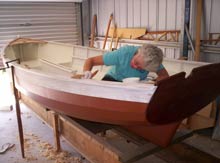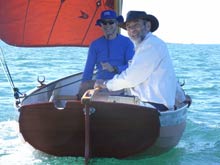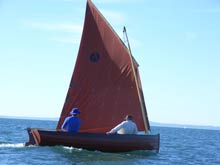In the last couple of decades there has been a resurgence of activity in the building of boats by amateurs. Not that it had ever died out among the determined core group of enthusiasts, but the recent increase in boatbuilding activity seems to be the result of many new entrants into the game giving it a go for the first time. To a large extent this is being driven by a number of excellent magazines, but it is also a demonstration of a basic need inside certain people to make something with their own hands, or to realise some creative instinct.
s.jpg) |
In the last couple of decades there has been a resurgence of activity in the building of boats by amateurs. It is a demonstration of a basic need inside certain people to make something with their own hands, or to realise some creative instinct. |
I symathise with such feelings, having been subject to them since childhood. My life has been enriched by hundreds of books about boatbuilding, boat design, and boat use, and I have been lucky enough to have always had a good boat on hand to ensure that there was more to my boating than just reading and dreaming. However, the years and years of reading have given an extra dimension to my passion, and have allowed me to learn from some of the masters, via the printed word.
The current wave of amateur boatbuilding has come at the same time as the rise of the personal computer and the internet. Never before has so much information been available at short notice. But the downside is that much of the information is totally unedited, and from sources which are anonymous, or ignorant, or both. In the past, boatbuilding information came from a teacher who had experience, or from a published book. The publishers tended to ensure that the material in the books was of high quality before committing large sums of money to publication of what would normally be an expensive specialist book. The system was self-regulating to a large extent, when it came to quality of information.
| In the past, boatbuilding information came from a teacher who had experience, or from a published book. The publishers tended to ensure that the material in the books was of high quality. |
 |
Things have changed! The good quality information is still there, and is being added to in significant amounts. But the good stuff is being diluted by low-grade material being published on the internet by people without the necessary understanding and experience. Please be very careful about what information you rely on for your learning. Enjoying small boats is one of the most wholesome and rewarding things which can be done in this life, and there is plenty of good help around if you know where to look. But you must be very careful!
When I first started building boats the available plans were quite basic in their presentation. Usually one was presented with a set of lines, an outboard profile, a sail plan and, maybe, a construction plan – frequently with all of the above being on a single sheet! Central to the design would be the Table-of-Offsets stuck up in a corner of the drawing, and from that table the entire design could be brought to life. To possess the Table-of-Offsets was to possess the design.
Full-size lofting of the boat’s lines was the first step in the building process - if you didn’t know how to loft and build the boat, a few nights of serious reading were the key. Those lucky enough to have a teacher were many steps ahead.
s.jpg) |
The good stuff is being diluted by low-grade material being published on the internet by people without the necessary understanding and experience. |
The point about all of this is that people were not spoon-fed. Building a boat successfully required thought, research, and effort. The same can be true today, but increasingly, some people are skipping the thought and research bit and just going on to the effort. In the process, they loose much of the satisfaction which is contained within the activity.
Nowdays, there are more plans available than ever before, as all of the old ones are still obtainable and many, many new ones are being published each year. Noticeable differences in the newer plans include full-size patterns, and/or dimensioned drawings which allow the builder to mark material directly without carrying out a lofting. The other change is in the provision of written instructions and accompanying photographs. In some plans, the instructions are so detailed that they become a book in their own right.
Now, having detailed plans with comprehensive instructions is a good thing, but the builder shouldn’t turn off the brain altogether. There is a need to understand what is being done, rather than just following the instructions in a ‘paint-by-numbers’ fashion. Read, think, observe, question, experiment, make mistakes – but do it for yourself so that when the job is finished you know that you have been part of the process, rather than having been a robot.
| The builder shouldn’t turn off the brain altogether. There is a need to understand what is being done, rather than just following the instructions in a ‘paint-by-numbers’ fashion. |
 |
Boatbuilding is a rich and rewarding subject, but like all good things, the best rewards come from effort put into something which is not necessarily easy. Don’t skip details – it has been said that in boatbuilding, even the best is not quite good enough. That doesn’t mean that boatbuilding has to be difficult – on the contrary, some exceptionally good boats can be built very easily – but it does mean that what you do must be done properly using the best available materials.
A boy I knew (now a man) built a small sailing boat when he was fourteen-years-old. It was not a particularly simple boat, being a lapstrake (clinker) hull with decks, buoyancy tanks, and a large sailing rig. But he got the job done. There were a few errors in the construction, but the boy had used good quality materials, and being an intelligent fellow, he had applied lessons learnt from books and the advice of teachers in the field. When he had finished the boat, this young chap sailed her in many different locations, including a memorable trip of 35 kilometres in serious open-water conditions. Seven years down the track and the boat is still in fine condition, because she was built without short-cuts, and using high-quality materials. He will be able to pass her on to his own children, and they in turn, will benefit.
 |
One thing I noticed many years ago at a big boat show was that people in their hundreds would run their hands along the planking of a beautiful wooden boat, as though they could absorb some of her magic. They didn’t do it to the manufactured hulls made from fibreglass or aluminium. |
I guess that it sounds as though I’ve been giving a lecture. But I look at the beauty of a well-designed and well-built boat and know that this activity is something really worthwhile in a world gone mad. One thing I noticed many years ago at a big boat show was that people in their hundreds would run their hands along the planking of a beautiful wooden boat, as though they could absorb some of her magic. They didn’t do it to the manufactured hulls made from fibreglass or aluminium. There is something basic and good about a hand-built wooden boat. You can build one too, but remember to read, research and think for yourself. It may change your life… |

